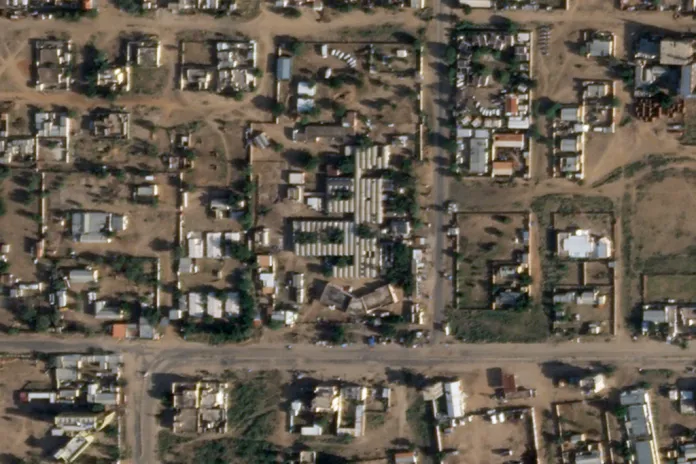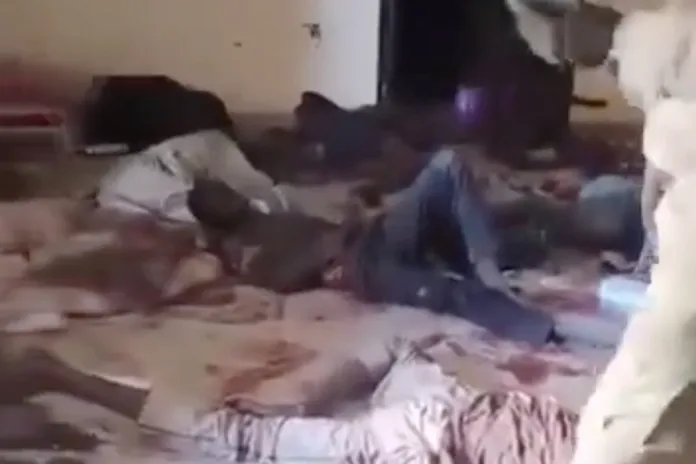Thousands are feared dead in a massive killing spree after the Sudanese Rapid Support Forces seized the last major population center in western Sudan.
Sudan has been engulfed in a bloody civil war since April 2023, when a power struggle between RSF leader Mohamed Hamdan Dagalo, also known as Hemedti, and Sudanese Armed Forces leader Abdel Fattah al-Burhan escalated into open conflict. After suffering a major setback in March by losing the capital of Khartoum, the RSF regained the initiative in the following months, culminating in the SAF withdrawing from its last stronghold in western Sudan, El Fasher, leaving it at the RSF’s mercy.

What ensued was one of the largest mass killings of the war, with RSF soldiers murdering hundreds, if not thousands, of civilians.
RSF fighters have become infamous throughout the Sudanese Civil War for proudly filming their atrocities and posting them on social media. Despite a complete media and communications blackout, making specifics hard to determine, videos trickled out of El Fasher showing the brutality being unleashed on the civilian population.
The RSF is primarily made up of ethnic Arabs or Arabized Africans, and has showcased extreme racism and animosity towards non-Arab Sudanese.
One video released by an RSF fighter showed him and fellow gunmen pursuing crowds of black civilians on trucks, yelling, “Kill the blacks!”
Another video proliferated across social media showed an RSF gunman shooting an unarmed man in civilian clothing with a machine gun dozens of times point-blank, causing his body to partially disintegrate. Multiple videos showed RSF fighters executing unarmed men in civilian clothes, while others showed piles of civilian corpses.
In one of the most grisly videos, RSF fighters were seen walking over dozens of bloodied corpses in a hospital, identified as the Saudi Maternity Hospital, executing any survivors. The World Health Organization later reported that 460 patients and their companions were murdered in the hospital alone.

This is just following the traditional playbook of the RSF,” Michael DeAngelo, an Africa analyst at the American Enterprise Institute’s critical threats project, told the Washington Examiner, tracing their conduct back to their origins as the paramilitary janjaweed in the Darfur Genocide in the early 2000s.
“They go into an area, they clear the SAF out, and then they target civilians from there. A lot of times, it’s based on ethnic lines, so targeting non-Arab ethnic groups, and this has just been something that they’ve done since … the Darfur Genocide in the early 2000s,” he added.
Liam Karr, Africa team lead at the American Enterprise Institute’s critical threats project, described the killings as “systematic,” with fighters going house-to-house and executing non-Arabs.
The true scale of the killings was confirmed by satellite imagery from Planet Labs, analyzed by the Washington Post.
In a detail noted as a first by many open-source intelligence analysts, satellite imagery captured massive pools of blood in the city visible from space.
In a Monday statement obtained by the outlet, the RSF said it was “combing operations on a large-scale” in El Fasher, “aiming to eliminate the last of the terrorists and mercenaries’ strongholds.” It expressed its “utmost commitment to protecting civilians.”
The scale and targeted nature of the killings, together with previous massacres, have led some to argue that the RSF is committing genocide. Among these is the U.S., which sanctioned RSF leaders last year over the accusations.
Karr and DeAngelo were hesitant to label the killings as genocide due to the high burden of proof regarding intentionality needed to reach the designation, and the lack of information coming from El Fasher.
Aside from the human toll, the capture of El Fasher also serves as a major strategic blow to the SAF, changing the war’s course. The city was the last bastion of government control in the RSF’s stronghold — the other four major population centers in Darfur had been captured in the first year of the war. With El Fasher lost, the SAF is expelled from the France-sized area, with little hope of retaking territory in the near future.
The map of control is now neatly split between the RSF-controlled western half and the SAF-controlled eastern half.
“The fall of El Fasher really does represent the RSF’s full consolidation of control over Darfur region, and Darfur region is also where most of the RSF fighters are from,” Sudan specialist and human rights researcher Jehanne Henry told the Washington Examiner in an interview.
The most likely next step of the Sudanese Civil War will be for it to descend into a stalemate, with the RSF further consolidating control over Darfur and the SAF consolidating control over the rest of the country. The possibility that Sudan could be partitioned is now viewed as a likely possibility.
“A lot of analysts made the point that, even from the very beginning of the war… well, what could happen in this war? Maybe the RSF will take Darfur, let them have it, then we’ll just move on. So there’s a school of thought in the rest of Sudan that, yeah, this was inevitable, and the division, the de facto division of Sudan, was kind of in the cards from the beginning,” Henry explained, though clarified that she doesn’t entirely fall into this camp.
“With the latest news, it’s not clear that the SAF has the ability to make inroads back into Darfur, and it looks more like the SAF will focus on the areas of the country that it already controls,” she explained.
Liam Karr, Africa team lead at the American Enterprise Institute’s critical threats project, and DeAngelo gave a similar analysis.
“We have two parallel governments here. We have a conflict that seems to be reaching some kind of stalemate, with one group in control of half the country, another group in control the other half, and neither side wanting to form a government to recognize the legitimacy of the other,” Karr said.
“So that naturally lends itself to if people want to stop the conflict, the easiest way to do so would be some kind of Libya-like scenario, where you partition the state and then try to figure out some road map to re-merge the two sides of the future. But obviously, as Libya has shown, that’s quite difficult,” he added.
Another issue in the conflict is the nature of the SAF, which Henry describes as not entirely a military, but more a collection of militias. Many of these militias are Islamist and have a human rights record nearly on par with the RSF.
Whether the atrocities of the RSF and SAF are comparable is an open question. Karr and DeAngelo argued that the RSF is clearly worse, while Henry argued that the situation is less clear.
The propensity of RSF fighters to film their atrocities to brag online has made their crimes much more widely known, but the SAF’s crimes are no less “gruesome,” even if not typically filmed, Henry said. She said the two beligerents are “comparable,” but that a definitive worse side can’t yet be established.
“I really don’t think that we have enough evidence to scientifically conclude that one side is worse than the other. In view of… different tactics at different times, and whether they’re filming or not filming, there’s a lot we don’t know,” she said.
The international involvement has helped promote the Sudanese Civil War into the greatest humanitarian crisis on Earth. The SAF enjoys backing from Egypt, Turkey, Russia, and Iran, largely due to security and economic interests. The true decisive player, however, has been the United Arab Emirates, which has pumped a tremendous amount of money and weapons into the RSF, helping to revive it this year.
The UAE’s interests lie in Sudan’s gold mines and economic infrastructure, believing the RSF has the key to increased access to the country.
A Wall Street Journal report on Tuesday, citing U.S. officials who viewed Separate reports, including from the Defense Intelligence Agency and the State Department’s intelligence bureau, claimed that Abu Dhabi had greatly expanded its support for the paramilitary group earlier this year. It reportedly gave the RSF a key edge over its adversary by supplying advanced Chinese-made drones, small arms, heavy machine guns, vehicles, artillery, mortars, and ammunition.
“The war would be over if not for the U.A.E.,” Cameron Hudson, a former chief of staff to successive U.S. presidential special envoys for Sudan, told the outlet. “The only thing that is keeping them in this war is the overwhelming amount of military support that they’re receiving from the U.A.E.,” he said of the RSF.
DeAngelo gave a similar analysis, saying that the only way to end the conflict was for the U.S. to seriously punish the UAE for its actions.
SUDAN’S HUMANITARIAN CRISIS THREATENS US REGIONAL INTERESTS
He noted that the UAE is susceptible to pressure, even citing an incident last year where Abu Dhabi was able to get the RSF to call off an impending massacre after a United Nations resolution.
“So the UAE does actually respond to pressure. It’s just up to the U.S. and others to actually enforce that pressure, because what we’ve seen really is the UAE and the RSF constantly dragging its feet,” DeAngelo said.























